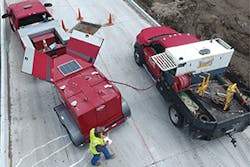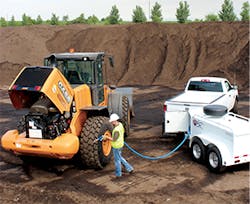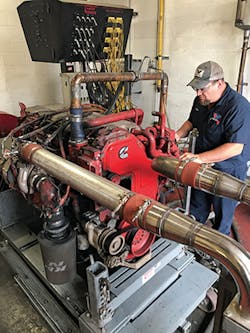Fluids are essential to machine health but are too often overlooked and under-prioritized. Also, many only learn basic or general fluid maintenance information, and this, plus some misinformation, often leads to less optimal machine productivity and longevity and can lead to catastrophic failure.
The Squeaky Wheel Gets the Grease
“Oil is a very complex fluid these days; it’s amazing how much engineering goes into the design and deployment of today’s high-quality engine oils,” says Dr. Roger England, technical director, Valvoline Inc. “It’s true for engine oil, coolants, and hydraulic fluid; it runs the gamut. These are some of the reasons we have a very close relationship with Cummins. When Cummins starts down the path to design
a new engine, we’re there looking at all the things they are going to expect from the oil, how they’re constantly changing the internal combustion playing field, and how we can be more effective.”
A machine’s fluids need to be monitored, changed or refilled, stored properly, and be at sufficient levels for normal operation. Failure to do so can lead to catastrophic failure. Oil can become corrosive inside an engine, but additives added to the oil mitigate the corrosive potential.
“People think oil is designed solely to lubricate, but it’s also designed to cool, seal, and clean. Most heavy-duty engines today have piston cooling nozzles, and the oil must be able to cool the piston for the engine to run properly. Oil is also designed to seal; it’s an integral part of sealing the piston ring to the liner, and the liner is designed and manufactured to work in concert with the engine oil. Cleaning is why the oil turns black quickly during use. However, over time, these abilities of the oil get consumed, and the oil needs to be changed. A lot of issues can be created that are not related to lubrication by not changing the oil at the proper time. Valvoline has a great used oil analysis program to help guide maintenance, so you are not creating unnecessary wear on your engine, or throwing away good oil.”
Proper fluid care begins with daily checks.
“Every commercial equipment owner should have a daily checklist that operators should review before putting the equipment to work. This should include at least a check of all fluid levels. Engine oil, engine coolant, brake, and hydraulic systems are most critical,” says Tony Negri, commercial product manager, ConocoPhillips.
“Operators should conduct a basic visual walk around every morning before operating the equipment. During these daily checks, operators should inspect all hose and fitting connections for leaks, check the sight gauge at the oil reservoir to ensure proper fluid levels, and monitor the hydraulic oil filter gauge to determine how saturated the filter may be, replacing elements as necessary,” says Ben Gillum, training and education assistant manager, Muncie Power.
Gillum continues: “If you start up the system without doing any checks, and you’ve ignored a leak somewhere, the fluid level is going to be low in the reservoir. Depending on the application, this could cause a multitude of problems. Avoiding pipe thread or NPT fittings is recommended, as they are more prone to leakage than JIC or SAE, o-ring, type fittings.”
Then, make sure your regular maintenance program is sufficient.
“When it comes to maintenance, every application is different. Regular maintenance schedules for each particular application should be determined by testing samples of your hydraulic fluid. This should be completed within the first year of operation, at least twice, to gauge the rate at which your hydraulic fluid is breaking down. There is some cost involved with test sampling, but the cost is insignificant when compared to the damage potentially caused otherwise. When you’ve got a good idea of the durability of your fluid, you can then decide on a regular interval for subsequent testing and/or a complete system flush and fluid replacement. Once established, you should use these regular maintenance intervals to check the PTO and the hydraulic pump for wear, including shaft fretting and seal/bearing condition. It is recommended to pull the pump apart from the PTO and check the splines to make sure that the teeth are in good shape and not rusty or corroded,” says Gillum.
“Many people rely on the operator for maintenance; however, with today’s technology combined with demands to get the job done quicker, we recommend an auto-lubrication system,” says Mike Michaud, account executive, Beka-Lube Products Inc. “This allows the operator to continue working, while at the same time, the machine gets lubricated. The automatic lubrication system comes on at predetermined times and the proper amount goes into each of the pins while they are working, which is much more effective than greasing them when they are not moving. This helps to eliminate the maintenance part of the program and takes the guesswork out of the job (too much, too little, not often enough).”
Michaud continues: “The lack of maintenance of the greasing of the pins can actually cause a seizure of the pin. This is where you get the cost part of the maintenance. With a seized pin you can actually incur more costs getting the bushings replaced than it would have cost to get the automatic lubrication system installed in the first place. We’ve seen that happen. After incurring the costs for bushings replacement, the owner calculated that for the cost of replacing the components, he could have installed an AutoLube system on it, increase the longevity of the machine, as well as get better trade-in value and eliminate an unplanned downtime.”
“Prevention is everything,” says Gillum. “If you can keep the oil clean and cool, you can ensure optimum performance and life of all the components within the hydraulic system. Work with your local hydraulic shop to define the optimal fluid for your application and determine the appropriate climate. Keep in mind, biodegradable fluids are not approved for use with roller bearing-style pumps. Filters have to be installed to catch contaminants before they reach the reservoir, either in the return line or in the pressure line. The filter elements need to be replaced on a regular basis. There is a gauge that tells you when the filter is full; when it is, it goes into bypass mode and won’t filter anymore, so it’s time to replace your filter element. In a new system, there will always be built-in contaminates; therefore, we recommend replacing the filter elements after the first hour of operation and then again within the first week. After that, just keep an eye on the gauge.”
Gillum continues: “Regarding cavitation, special care must be taken to ensure the proper size and type of hydraulic hose is used. There is a difference between the inlet hose, designed to withstand vacuum conditions, and pressure hose, designed to withstand outward pressure. Utilizing the proper type and size of the hose will help immensely in creating the optimal working conditions for your hydraulic system. Keep in mind, suction line strainers, shut-off valves, and suction filters are all going to increase the chance of cavitation at the pump, as they are restrictions to the oil supply. If required, make sure to size and monitor these components accordingly.”
The greatest threats to oil’s integrity, which it needs in order to do what is expected of it, are particulates/contamination, water, heat, and aggressive operation.
“Contamination is the number one cause of failure for hydraulic pumps followed by cavitation,” says Gillum. “In addition to a good filter, proper maintenance should include regular cleaning of the reservoir while being careful not to saturate the area immediately surrounding the breather cap. This will help to prevent particulates from being pulled in through the breather.”
Keep DEF fluid clean and the levels in your machine sufficient in order to avoid damaging parts of your machine’s engine.
“Low oil levels increase oil degradation and associated issues. If you run an engine with contaminated oil, you can quickly see increased lead and copper in used oil analysis because the weak organic acids in the oil are etching out those soft metals,” says England. “Even when you have a good total base number (TBN), you think that it would counteract all the acid in the oil, like matter and anti-matter on Star Trek, but that’s not the case. What happens is the base (alkalinity) has a high affinity for water, and the water prevents the base from reacting with weak acids. This is more prevalent in engines running ultra-low sulfur diesel fuel since many of the acids formed are of a weak organic variety. In a diesel engine, you produce about one gallon of water for every gallon of fuel burned, and so a lot of that ends up in or around the crankcase, it becomes a very humid environment. Today we depend on the oxidation and nitration measurements in used oil analysis rather than the TBN numbers.”
Water contamination can severely damage the components with which it comes into contact. Since water isn’t soluble in oil and doesn’t form a homogenous liquid with oil, it is an emulsion. Water emulsion refers to a fine dispersion of minute droplets of water in an oil in which it is not soluble or miscible.
The water can also damage the base oil of a lubricant, causing a change to the oil’s viscosity, making it more sludge-like and possibly leading to acid formation. And, it can cause problems such as oxidation (the oil becomes combined chemically with oxygen; hydrolysis), the reaction of water with the base oil; and aeration, the introduction of air into the oil.
“Water is bad for oil. You hear the saying ‘oil and water don’t mix’? It’s very true. Water in oil will start tying up a lot of the additive package, so you want to keep water away from engine oil. For that reason, we have to be careful about how we store oil, even when it’s in smaller containers,” says England.
“If you run a shop, you should keep a limited amount of bulk oil on hand,” continues England. “Keeping bulk oil on hand can be problematic depending on the environment. If you experience temperature changes such that you go through a dew point in the air, water that condenses in bulk tanks can become a major worry. If you have questions, it’s good to get an inexpensive analysis done to quantify the amount of water in the new oil, which is the same measurement we run on used oil.”
Another major worry is heat. “Once oil gets hot, you lose the additives that help prolong system life; and they don’t come back. Once they boil out, they’re gone. Like I said, prevention is everything. Every hydraulic system is unique, but if you keep the oil cool and filtered, you should only have to change the oil every few years or so depending on your application,” says Gillum.
Any application where a machine doesn’t travel much and “sits” in its own waste heat can lead to faster oil degradation. “In off-road applications, like construction and excavation, it’s a challenge to get the waste heat away from the engine fast enough so that it doesn’t degrade the oil,” says England. “At Valvoline, we work with our partners to be able to create oils that survive well in high-temperature environments. One of our hallmarks of success is our ability to create products that are very resistant to oxidation.”
How you use the equipment changes how fast the oil degrades. “If you run your equipment in a very aggressive manner, you have to change the oil more often. If you use the equipment in a lightly loaded manner, you may not need to change it so often. Used oil analysis is the key to this determination,” says England. Maintaining fluids in the off-highway market is a unique challenge because those machines tend to work in aggressive environments.
“Commercial heavy equipment, whether owned or leased, is nearly always utilized to full potential. After all, the equipment owner is generating revenue. Severity levels are relatively demanding on the lubricants in use due to factors such as dirty operating environments, high loads, and wide-ranging ambient temperatures. Because of the severity of the duty cycle, commercial equipment owner/operators should always consider using premium lubricants for long-term durability, minimal downtime, and reliable system response from hydraulic components,” says Negri.
“Prevention is the best solution because the alternative is expensive,” says Gillum.
The Valvoline engine lab facility in Ashland, KY.
Low-Load and Idle Times Worse than Aggressive Applications
Fuel quality is critical to keep Tier 4 engines running smoothly. “While the new engines reduce diesel emissions and protect our health and the environment, the fact is they are rather finicky about fuel,” said William “Bernie” Bernhard, Association of Equipment Manufacturers technical and safety services manager. “Among other things, it is subject to change and contamination as it moves from the refinery to the engine, making storage, temperature, age, and filtration and related factors critical in maintaining fuel quality.”
US Environmental Protection Agency (EPA) regulations require a great reduction in the amount of sulfur in diesel fuels and emission levels from diesel engines and vehicles. To meet these regulations, the petroleum industry is producing Ultra Low Sulfur Diesel (ULSD) fuel with a maximum of 15 parts-per-million (ppm) of sulfur, thereby significantly reducing emissions. As of December 1, 2010, all highway and non-highway diesel fuel offered for sale must be ULSD fuel.
“Improper DEF [diesel exhaust fluid] care will absolutely create service issues and failure issues, so I coach people to think about DEF differently,” says Luke Van Wyk, VP – Sales, Thunder Creek Equipment. “It’s not an oil; it’s a consumable. It has to do its job of creating a chemical reaction in the catalyst system.”
According to Van Wyk, tough applications don’t put a stress on DEF or degrade it. “For DEF, diesel fuel and oils, low load or idle time on a Tier 4 engine is one of the biggest threats, and it really comes down to heat, especially in an SCR system that uses DEF,” he says. “When a machine idles for a prolonged period of time, the exhaust catalyst, which, with the help of DEF, is used to break down NOx (nitrous oxide), can’t stay at active temperature, and so it cannot catalyze the reaction, leading to build up or failure of an SCR and a DEF system. On the fuel side, the fuel will not burn well, meaning a greater risk of unburnt fuel getting into the oil mitigating its effectiveness. And, we won’t be able to get the oil to flow and be at the optimal temperatures for its purpose.”
However, DEF degradation happens often in the storage process. Like most fluids, DEF has a shelf life. “There’s a lot of misinformation about DEF shelf life and degradation,” says Van Wyk. “DEF is a product comprised of two materials—automotive-grade urea and de-ionized water. It has a shelf life for two reasons. Reason number one: the urea used in the exhaust process has no aldehydes—that preservative would have a negative reaction in the catalyst. It would actually plug it up; it creates a tar-like substance. DEF shelf life can be up to three years in northern climates, 18 months in the mid-west, and 12 months in the south.”
Van Wyk continues: “The same is true for diesel fluid; it also has a shelf life. Traditional diesel has a shelf life of six to nine months and for heavier blends—the biofuels—shelf life decreases to three to six months. It’s very important for fleet managers to turn over their fuel stock to ensure overaged fuel doesn’t begin to create in-field maintenance issues in their equipment.”
And, just as temperature is important during the combustion process, prolonged storage at higher temperatures will cause hydrolysis to occur.
When fuel expires, the molecular integrity of the fuel can begin to break down. “Prolonged storage of fuel becomes more susceptible to water infiltration,” says
Van Wyk “The EPA a number of years ago moved to an ultra-low sulfur fuel. It doesn’t do a good job of holding the water in suspension—it expels water. As the water builds up, it becomes more susceptible to biological reactions such as algae or other unfavorable things building up in the fuel.”
It can also create problems in the high-pressure common rail injection systems. “The water can work like a waterjet; it gets injected at 25,000–40,000 psi and pits or cuts and therefore degrades cylinder heads,” says Van Wyk.
Therefore, money saved by purchasing fuel in bulk when prices are low can easily lead to even greater costs due to increased equipment downtime and repair costs if the fuel expires from prolonged storage.
“The SCR is a catalytic converter, and it can’t mitigate the NOx output of diesel engine emissions in the same way that a gas engine catalytic converter can. It needs help. DEF fluid is the material that helps,” says Van Wyk. “The rare metals catalyst has reactive centers that help in creating a chemical reaction. The DEF is injected into the exhaust stream ahead of the catalytic converter, and that bonds with the NOx particles, and then with the help of the nitrogen that is in the urea, the catalytic converter breaks down the NOx into nitrogen and water vapor.”
Van Wyk continues: “Urea and DEF itself is a corrosive product, and the thing we need to be aware of in how we handle DEF is avoiding any metals infiltration, such as iron, copper, chromium, or zinc into the DEF supply. It will get trapped inside the catalyst and then rust the catalyst from the inside out. And that cannot be repaired; it can only be replaced.”
One of the most important qualities of diesel exhaust fluid is its purity. Less than one teaspoon of any corrosive metal, for example, would contaminate 5,000 gallons of DEF; SCR (selective catalytic converter) systems are very sensitive to potential impurities, so it is essential that exhaust fluid remains uncontaminated and adheres to the ISO 22241 quality standard.
According to Yara International ASA, a Norwegian chemical company with US operations for 70 years, using contaminated or inferior DEF or something other than DEF can result in the following consequences:
- void warranty claims pertaining to the machine’s SCR exhaust injection system or catalyst
- downtime—the SCR system is susceptible to minerals found in water
- gradual degrading and clogging of the SCR system, resulting in costly replacement parts, reduced efficiency, and lost time
- the machine’s onboard diagnostics system can detect when the SCR system is not performing efficiently and can shut down the machine
- your machine will be operating illegally and treated accordingly by enforcement authorities
To eliminate confusion about which is the DEF tank intake and which is the diesel tank intake, the two intake holes are of different sizes and colors. DEF is blue on all machines from every heavy equipment OEM. However, if you manage to discover that there is DEF in the diesel tank or diesel in the DEF tank, Yara recommends that you don’t start the engine and don’t move the vehicle.
If the engine is started, the fluid will enter the wrong system. DEF is not compatible with some metals and materials, so it will slowly degrade the fuel system’s pipework and components. Diesel will poison the catalyst which is costly to replace (unwarrantable damage), resulting in downtime and maintenance bills.
“If you don’t keep DEF free from contaminants, you will introduce an infection into the SCR system that will eventually kill that catalyst,” says Van Wyk.
If the DEF tank runs low, the machine alerts the driver with visual and then audible alerts in varying degrees. If the DEF tank runs dry, the engine’s power is reduced. The machine is put into “limp” mode. It has the power to slowly crawl to a trailer or to the garage.
For on-the-job construction equipment DEF and diesel refills, Thunder Creek Equipment creates equipment to handle fluids in off-highway environments. “We have equipment that handles DEF, diesel, and oils. We promote closed DEF handling from package to package; we want to keep it a closed seal system, so there is no risk of contamination. The on-highway market—a truck, for example, goes to the source of DEF to fill up. In off-highway applications, you have to bring it to the machine.”
The company’s Multi-Tank Trailers (MTT) fuel and service trailers can legally transport bulk diesel on the road without requiring drivers to maintain a CDL or HAZMAT endorsement. Dirty construction environments prove a real challenge to keeping DEF pure, reinforcing the need to use closed DEF handling from package to package.






